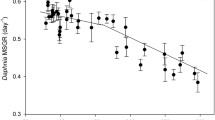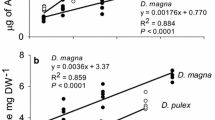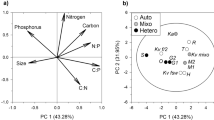Abstract
Herbivores often encounter nutritional deficiencies in their diets because of low nutrient content of plant biomass. Consumption of various diet items with different nutrient contents can potentially alleviate these nutritional deficiencies. However, most laboratory studies and modeling of herbivorous animals have been done with diets in which all food has uniform nutrient content. It is not clear whether heterogeneous versus uniform food of equal overall nutrient content is of equivalent nutritional value. We tested the effects of dietary mixing on performance of a model organism, Daphnia. We fed two species of Daphnia ( D. galeata, D. pulicaria) with diets of equivalent bulk stoichiometric food quality (C:P) and studied whether they would produce equivalent performance when C:P was uniform among cells or when the diet involved a mixture of high C:P and low C:P cells. Daphnia were fed saturating and limiting concentrations of a uniform food of moderate C:P (UNI) or mixtures (MIX) of high C:P (LOP) and low C:P (HIP) algae prepared to match C:P in UNI. Daphnia were also fed HIP and LOP algae separately. Juvenile growth rate and adult fecundity were measured. D. galeata performance in UNI and MIX treatments did not differ, indicating that partitioning of C and P among particles did not affect dietary quality. Similarly, D. pulicaria‘s performance was similar in the MIX and UNI treatments but only at low food abundance. In the high food treatment, both growth and reproduction were higher in the MIX treatment, indicating some benefit of a more heterogeneous diet. The mechanisms for this improvement are unclear. Also, food quality affected growth and reproduction even at low food levels for both D. pulicaria and D. galeata. Our results indicate that some species of zooplankton can benefit from stoichiometric heterogeneity on diet.


Similar content being viewed by others
References
Ahlgren G, Lundstedt L, Brett M, Forsberg C (1990) Lipid composition and food quality of some freshwater phytoplankton for some cladoceran zooplankters. J Plankton Res 12:809–818
Andersen T (1997) Pelagic nutrient cycles; herbivores as sources and sinks. Springer, Berlin Heidelberg New York
APHA (1992) Standard methods for the examination of water and wastewater. American Public Health Association/Water Environment Federation, Washington, D.C.
Begon M, Harper JL, Townsend CR (1990) Ecology: individuals, populations and communities. Blackwell, Oxford
Boersma M (2000): The nutritional quality of phosphorus limited algae for Daphnia. Limnol Oceanogr 45:157−1161
Boersma M, Kreutzer C (2002) Life at the edges: is food quality really of minor importance at low quantities? Ecology 83:2552–2561
Butler NM, Shuttle CA, Neill WE (1989) Discrimination by freshwater zooplankton between single cells differing in nutritional status. Oecologia 78:368–372
DeMott WR (1982) Feeding selectivities and relative digestion rates of Daphnia and Bosmina. Limnol Oceanogr 27:518–527
DeMott WR (1986) The role of taste in food selection by freshwater zooplankton. Oecologia 69:334–340
DeMott WR (1988) Discrimination between algae and artificial particles by freshwater and marine copepods. Limnol Oceanogr 33:397–408
DeMott WR, Gulati RD, Siewertsen K (1998) Effects of phosphorus-deficient diets on the carbon and phosphorus balance of Daphnia magna. Limnol Oceanogr 43:1147–1161
Duncan A (1985) Body carbon in daphnids as an indicator of the food concentration available in the field. Archiv Hydrobiol 21:81–90
Elser JJ, Hassett RP (1994) A stoichiometric analysis of the zooplankton-phytoplankton interaction in marine and freshwater ecosystems. Nature 370:211–213
Elser JJ, Sterner RW, Chrzanowski TH, Schampel JH, Foster DK (1995) Elemental ratios and the uptake and release of nutrients by phytoplankton and bacteria in three lakes of the Canadian Shield. Microbiol Ecol 29:45–162
Elser JJ, Dobberfuhl DR, Mackay NA, Schampel JH (1996) Organism size, life history, and N:P stoichiometry. BioScience 46:674–684
Elser JJ, Sterner RW, Galford AE, Chrzanowski TH, Findlay DL, Mills KH, Paterson MJ, Stainton MP, Schindler DW (2000a) Pelagic C:N:P stoichiometry in a eutrophied lake: responses to a whole-lake food-web manipulation. Ecosystems 3:293–307
Elser JJ, Fagan WF, Denno RF, Dobberfuhl DR, Folarin A, Huberty A, Interlandi S, Kilham SS, McCauley E, Schulz KL, Siemann EH, Sterner RW (2000b) Nutritional constraints in terrestrial and freshwater food webs. Nature 408:578–580
Elser JJ, Hayakawa H, Urabe J (2001) Nutrient limitation reduces food quality for zooplankton: Daphnia response to seston phosphorus enrichment. Ecology 82:898–903
Fagan WF, Seimann E, Mitter C, Denno RF, Huberty AF, Woods HA, Elser JJ (2002) Nitrogen in insects: implications for trophic complexity and species diversification. Am Nat 160:784–802
Gorokhova E, Kyle M (2002) Analysis of nucleic acids in Daphnia: development of methods and ontogenetic variations in RNA-DNA content. J Plankton Res 24:511–522
Gulati RD, DeMott WR (1997) The role of food quality for zooplankton: remarks on the state-of-the-art, perspectives and priorities. Freshwater Biol 38:753–768
Futuyama DJ, Gould F (1979) Associations of plants and insects in a deciduous forest. Ecol Monogr 49:33–50
Hessen DO (1989) Factors determining the nutritive status and production of zooplankton in a humic lake. J Plankton Res 11:649–664
Hessen DO (1997) Stoichiometry in food webs-Lotka revisited. Oikos 79:195–200
Jaenike J, Markow TA (2002) Comparative elemental stoichiometry of ecologically diverse Drosophila. Funct Ecol 17:115–120
Johnson TB, Kitchell JF (1996) Long-term changes in zooplanktivorous fish community composition: Implications for food webs. Can J Fish Aquat Sci 53:2792–2803
Kilham SS, Kreeger DA, Lynn DG, Goulden CE, Herrera L (1998). COMBO: a defined freshwater culture medium for algae and zooplankton. Hydrobiologia 377:147–159
Knisely K, Geller W (1986) Selective feeding of four zooplankton species on natural lake phytoplankton. Oecologia 69:86–94
Koehl MAR (1984) Mechanism of particle capture by copepods at low Reynolds numbers: possible modes of selective feeding. In: Meyers DG, Strickler JR (eds) Trophic interactions within aquatic ecosystems. AAAS Selected Symposium, Series 85. Westview, Boulder, pp 135–166
Loladze I, Kuang Y, Elser JJ (2000) Stoichiometry in producer-grazer systems: linking energy flow and element cycling. Bull Math Biol 62:1137–1162
Lurling M, Van Donk E (1997) Life history consequences for Daphnia pulex feeding on nutrient limited phytoplankton. Freshwater Biol 38:693–709
Muller E, Nisbet RM, Kooijman SALM, Elser JJ, McCauley E, (2001) Stoichiometric food quality and herbivore dynamics. Ecol Lett 4:519–529
Muller-Navarra DC (1995a) Biochemical versus mineral limitation in Daphnia. Limnol Oceanogr 40:1209–1214
Muller-Navarra DC (1995b) Evidence that highly unsaturated fatty acid limits Daphnia growth in nature. Archiv Hydrobiol 132:297–307
Plath K, Boersma M (2001) Mineral limitation of zooplankton: stoichiometric constraints and optimal foraging. Ecology 82:1260–1269
Rothhaupt KO (1995) Algal nutrient limitation affects rotifer growth rate but not ingestion rate. Limnol Oceanogr 40:1201–1208
Strong DR, Lawton JH, Southwood R (1984) Insects on plants: community patterns and mechanisms. Blackwell Scientific, London
Sterner RW (1993) Daphnia growth on varying quality of Scenedesmus : mineral limitation of zooplankton. Ecology 74:2351–2360
Sterner RW (1997) Modeling interactions of food quality and quantity in homeostatic consumers. Freshwater Biol 38:473–481
Sterner RW, Elser JJ (2002) Ecological stoichiometry: the biology of elements from molecules to the Biosphere. Princeton University Press, Princeton, N.J.
Sterner RW, Hessen DO (1994) Algal nutrient limitation and the nutrition of aquatic herbivores. Annu Rev Ecol Syst 25:1–29
Sterner RW, Robinson J (1994) Thresholds for growth in Daphnia magna with high and low phosphorus diets. Limnol Oceanogr 39:1229–1233
Sterner RW, Schulz KL (1998) Zooplankton nutrition: recent progress and a reality check. Aquat Ecol 32:261–279
Tessier AJ, Bizina EV, Geedey CK (2001) Grazer-resource interactions in the plankton: are all daphniids alike? Limnol Oceanogr 46:1585–1595
Urabe J, Watanabe Y (1992) Possibility of N-limitation or P-limitation for planktonic cladocerans—an experimental test. Limnol Oceanogr 37:244–251
Urabe J, Clasen JJ, Sterner RW (1997) Phosphorus limitation of Daphnia growth: is it real? Limnol Oceanogr 42:1436–1443
Van Donk E, Hessen DO (1993) Grazing resistance in nutrient-stressed phytoplankton. Oecologia 93:508–511
Von Elert E (2002) Determination of limiting polyunsaturated fatty acids in Daphnia galeata using a new method to enrich food algae with single fatty acids. Limnol Oceanogr 47:1764–1773
White TCR (1993) The inadequate environment. Springer, Berlin Heidelberg New York
Acknowledgements
We thank W. Makino for his comments on the manuscript. Thanks also to J. Urabe for constructive discussion on the experimental design and to M. Boersma for sending raw data on D. magna growth. This study was supported by NSF Integrated Research Challenges for Environmental Biology Grant DEB-9977047.
Author information
Authors and Affiliations
Corresponding author
Rights and permissions
About this article
Cite this article
Acharya, K., Kyle, M. & Elser, J.J. Effects of stoichiometric dietary mixing on Daphnia growth and reproduction. Oecologia 138, 333–340 (2004). https://doi.org/10.1007/s00442-003-1444-8
Received:
Accepted:
Published:
Issue Date:
DOI: https://doi.org/10.1007/s00442-003-1444-8




